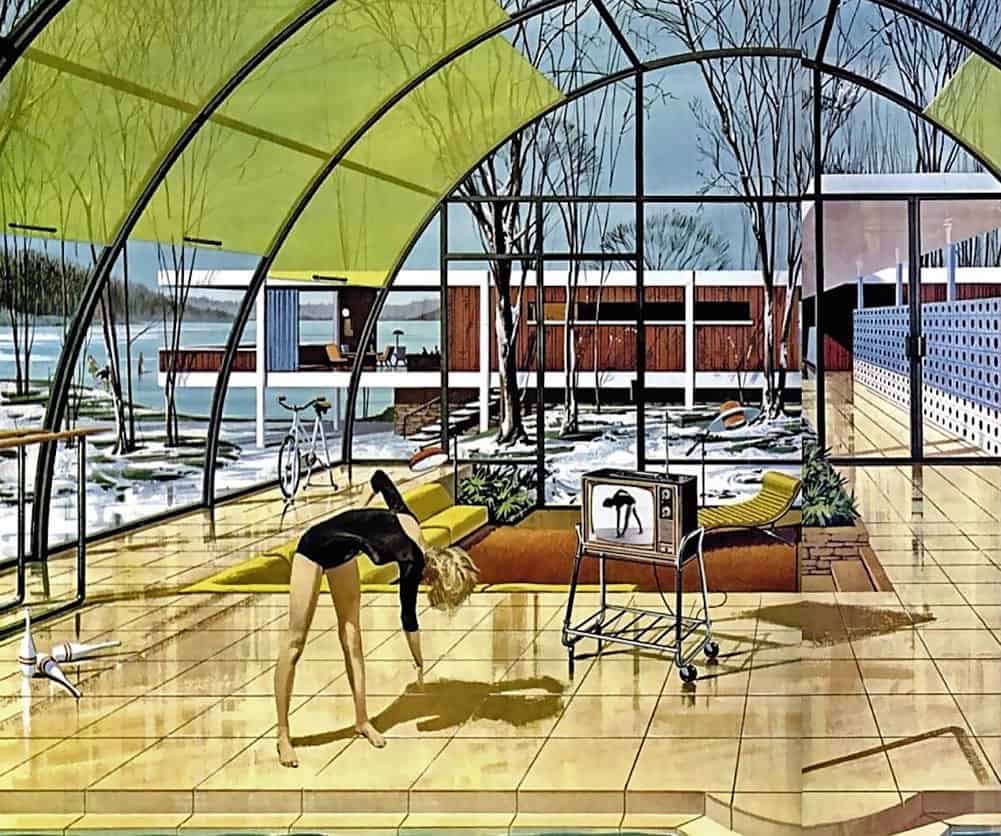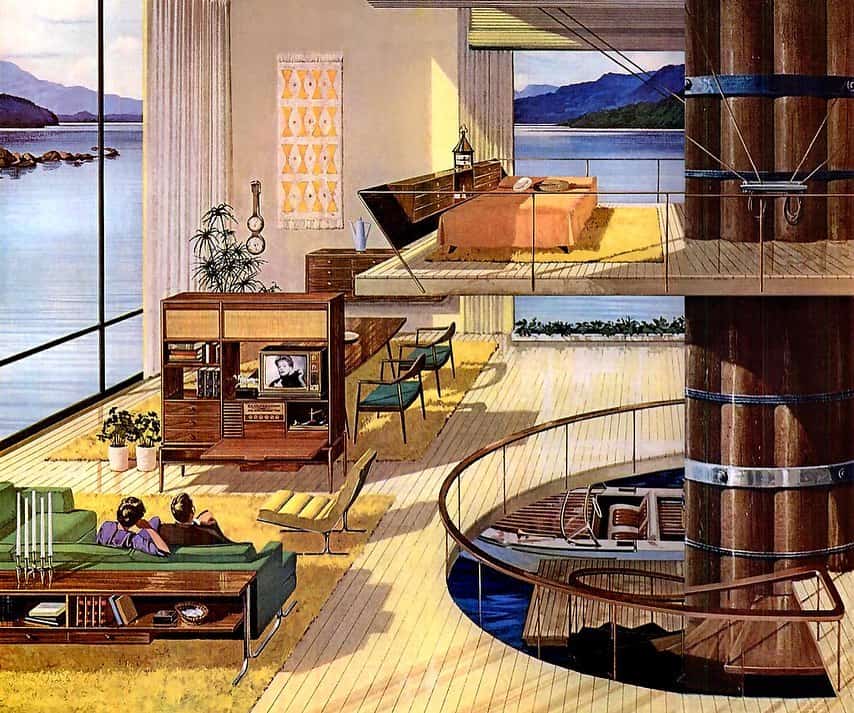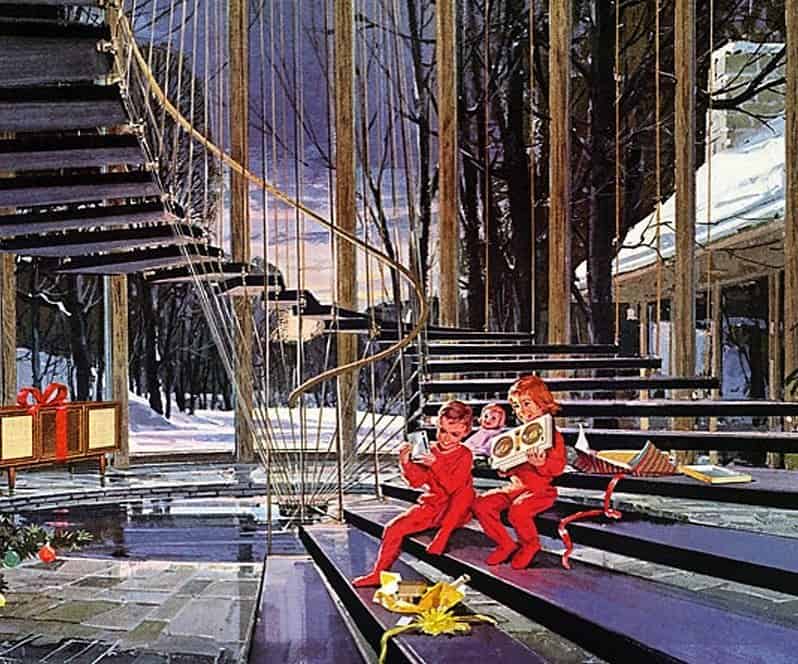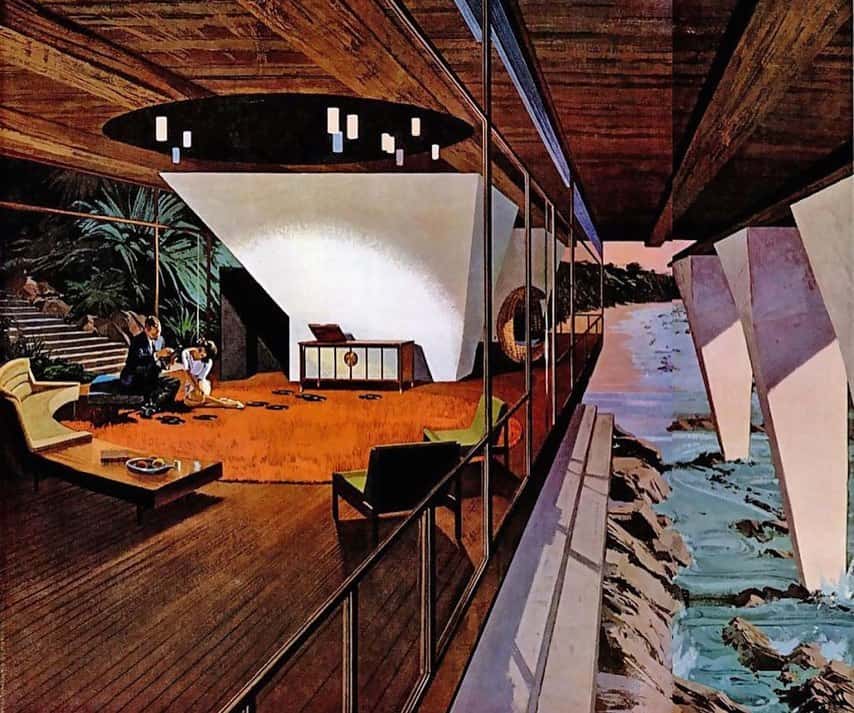Humans have always fantasized about the future, how our world will evolve, what new technologies will be invented, and how they will affect our everyday lives.
Charles Schridde’s ‘Houses of The Future‘ were stunning images published in the 60s and they represented how people then imagined houses in the 21st century.
From smart TVs to large portals, their imagination was surely out there – but there are some things that came true and we will still be using them in 2025!
Let us see how wild or realistic the ’60s ideas of the future of houses were!
1. Pools Inside a Living Room
Back in the ’60s, people imagined future homes where you’d casually watch your friends or family members swimming in the pool right from the coziness of your couch (like a live TV).
Also, they imagined that we would have indoor pools where you could freshen up in the afternoon.
Today, we’ve traded the “living room lagoon” for hot tubs and sleek infinity pools that look stunning on Instagram.
2. Portable TVs
In the ’60s, the idea of a TV you could move from room to room was mind-blowing.
Imagine watching your favorite show in your bed instead of the living room!
Today, portable TVs are practically prehistoric compared to our smartphones, tablets, and laptops.
You don’t even need a TV anymore because you can stream Netflix on a device small enough to fit in your pocket.
3. Large Terraces & One-Story Houses
Future homes in the ’60s were all about indoor-outdoor living, with enormous terraces that felt like extensions of the living room.
They imagined wide-open spaces to host swanky cocktail parties or sip coffee while watching the sunset (something that gives off a James Bond kind of aesthetic).
Fast forward to today, and while terraces still rock, we’ve turned them into stylish patios with outdoor kitchens, fire pits, and even Wi-Fi-enabled lounge areas.
4. Open Concept – Horizontally and Vertically
The ’60s had a wild vision for homes where walls would disappear completely, both between rooms and even floors.
It was about creating flowing, connected spaces, so you could shout to someone upstairs without breaking a sweat.
While we still love open-concept homes, we’ve got glass railings, floating stairs, and smart zoning instead of fully removing walls (because, let’s be honest, some privacy is still nice!).
5. Unusual Sofas
People in the ’60s thought the sofas of the future would be wild and very innovative and that new shapes would be the norm.
Kidney bean shapes, pod chairs, or even couches that look like giant cushions were among the favorite future designs.
Today, modular sectionals, bean bags, and even recliners that charge your phone prove they weren’t totally wrong, but nothing beats a classic sofa.
6. See-Through Walls
The idea of homes with transparent walls was futuristic and bold. Imagine living in a bubble where you could see the world, and the world could not see you.
In reality, we’ve dialed it down with massive floor-to-ceiling windows that flood spaces with light but keep your privacy intact with tinted glass and smart shades.
It’s a nice balance of letting nature in without turning your house into a fishbowl. So, this idea was not too far-fetched.
7. Integration with Nature
The ’60s dream homes were practically embedded in nature and they imagined trees growing through living rooms, gardens inside the house, and walls made of greenery.
Also, they envisioned living spaces where the line between indoors and outdoors didn’t exist. Today, some homes do apply these concepts.
We’ve got a biophilic design with living walls, massive windows, and smart home gardens that let you grow herbs without ever leaving the kitchen.
8. Cliff Homes
Back then, cliffside homes were the ultimate “future dream” – a house perched precariously on a rock, offering mind-blowing views of the ocean or mountains.
It was all about creating something daring, sleek, and impossibly modern.
Now, cliff homes are definitely real, but they come with insane engineering, glass floors, and infinity pools that make you feel like you’re floating above the world.
9. Open Ceilings and Voice Control
The ’60s imagined homes that could be versatile and have open ceilings whenever you wanted to have some sunlight indoors.
Pair that with voice-activated tech, and they believed you could control lights, temperature, or music just by talking to your house.
Today, skylights are common, and voice assistants like Alexa and Google Home are doing exactly what they dreamed (except now they can also order pizza for you or video call your sister who lives on another continent.)










